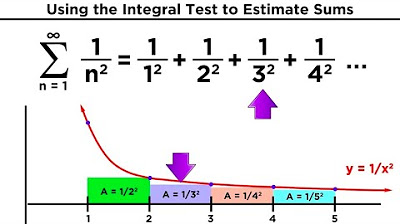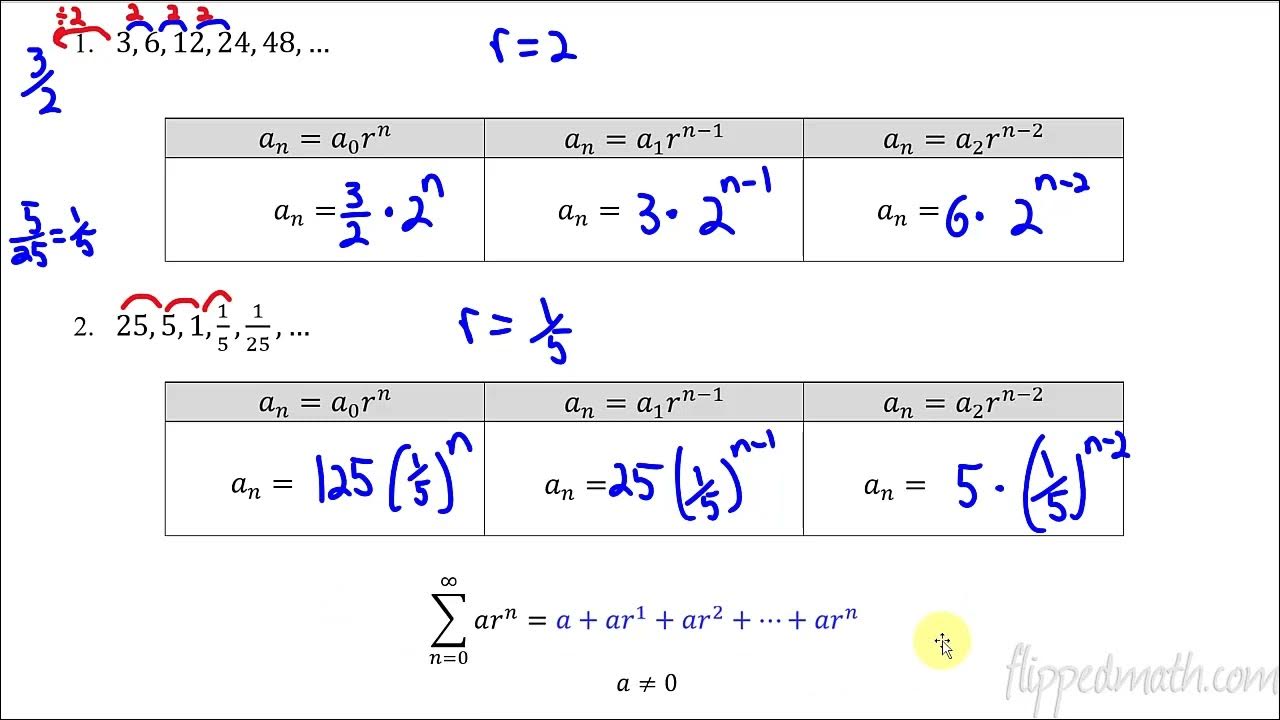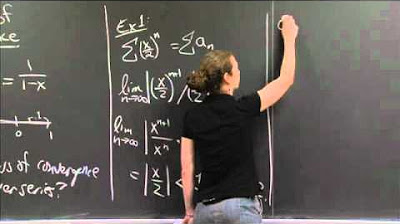Taylor Series Day 4
TLDRIn this educational video, the instructor discusses the convergence of infinite series, focusing on three key series: e^x, sin(x), and a geometric series. They explore the properties of these series, demonstrate how to determine their convergence, and apply calculus techniques to find derivatives and integrals of series representations. The session concludes with an example of finding the sum of an infinite series using the McLaurin series.
Takeaways
- 📚 The script is a lesson on determining the sum of convergent series, specifically focusing on series that are well-known and can be identified by their general term.
- 🔍 It introduces the concept of the ratio test to prove convergence but emphasizes recognizing patterns in series to identify their sums.
- 🌟 The first series discussed is e^x, which is a convergent series with the general term x^n/n!, and it equals e^x for all real numbers x.
- 📉 The second series is the sine series, s(x), which is an alternating series with the general term (2n+1)/ (2n+1)!, and it equals sin(x) for all real numbers.
- 🔢 The third series is a geometric series with alternating signs, which converges due to its structure and the absolute value of the common ratio being less than one.
- 📝 A theorem is presented that explains how to take derivatives and integrals of power series without changing the radius of convergence, but possibly altering the interval of convergence.
- 🔑 The script provides an example of finding the Maclaurin series for f(x) = 1/(1-x) by identifying its first few terms and the general term.
- ✅ The convergence of the series is discussed, noting that geometric series do not converge at their endpoints, and the interval of convergence is determined.
- 📈 The derivative of the series is found by differentiating term by term, and the resulting series is used to represent a new function, which is 1/(1-x^2).
- 🧠 The integral of the series is calculated by integrating term by term, and the resulting series is used to represent the integral of f(t) from 0 to x, which is a sum of powers of t.
- 📊 The script concludes with the sum of the infinite series being determined by evaluating the integral of 1/(1-x), which is the natural logarithm of the absolute value of (1-x), with the interval of convergence being between -1 and 1.
Q & A
What is the main topic of the video script?
-The main topic of the video script is the practice of determining the convergence of infinite series and identifying what they converge to, with a focus on specific series such as exponential over a factorial, alternating series with factorials, and geometric series.
What is the first series mentioned in the script that the instructor believes will converge?
-The first series mentioned is an infinite sum with a general term of an exponential over a factorial, specifically 3^n / n!, which the instructor believes will converge due to its form.
What does the series 3^n / n! converge to?
-The series 3^n / n! converges to e^3, which is e (Euler's number, approximately 2.71828) raised to the power of 3.
What is the second series discussed in the script, and what does it represent?
-The second series discussed is an alternating series with general term (2 * (2n + 1)) / (2n + 1)!, which is a representation of the sine function, sin(x), where x has been replaced with 2.
What is the third series in the script, and what is its convergence behavior?
-The third series is a convergent alternating geometric series with a general term of (-2/3)^n. It converges because the absolute value of the common ratio (-2/3) is less than 1, and it is an alternating series with terms approaching zero and decreasing in magnitude.
What theorem is mentioned in the script regarding the derivative and integral of a power series?
-The theorem mentioned allows for the term-by-term differentiation and integration of a power series. It states that the radius of convergence remains the same after these operations, although the interval of convergence might change.
How does the instructor demonstrate the application of the theorem on the function 1/(1 - x)?
-The instructor demonstrates by showing the first four terms of the series expansion of 1/(1 - x), then discusses the values of x for which the series converges, and finally applies the theorem to find the Maclaurin series for the derivative of the function.
What is the sum of the series found in part B of the script?
-The sum of the series found in part B, which is the derivative of the function 1/(1 - x), is 9/4 when x is replaced with 1/3.
How does the instructor find the sum of an infinite series that doesn't match any known series?
-The instructor uses the derivative found in part B and rewrites the series in a form that represents a known function. By integrating this function and evaluating it at specific points, the instructor determines the sum of the infinite series.
What is the final sum of the infinite series discussed in the script?
-The final sum of the infinite series, after integrating and evaluating at x = 1/3, is the natural logarithm of 3, or ln(3), because the series converges to -ln(1 - 1/3).
What is the significance of checking the endpoints in the interval of convergence for a power series?
-Checking the endpoints is important to determine if the series converges at the boundary values of the interval, which can affect the domain of the function represented by the series.
Outlines
📚 Understanding Convergent Series and Their Sums
In this paragraph, the speaker introduces the topic of convergent series and how to determine their sums. They discuss three specific series that are commonly known: the exponential series for e^x, the alternating series for sin(x), and a geometric series. The speaker explains that the exponential series converges for all real numbers and equals e^x, where x is replaced by 3 in the example. The alternating series for sin(x) is also described, emphasizing that it converges for all real numbers. Finally, the geometric series is mentioned, with a focus on its convergence criteria and the formula for its sum. The speaker uses these examples to demonstrate how to recognize and calculate the sums of convergent series.
🔍 Deriving Series for Derivatives and Integrals
This paragraph delves into the process of deriving series for derivatives and integrals. The speaker starts by discussing the convergence of a geometric series and how to use the McLaurin series to find the derivative of a function. They illustrate this with the function 1/(1-x), showing how to derive its series and determine the range of x for which it converges. The speaker then moves on to integrating series, explaining how to integrate term by term and how the interval of convergence might change. They use the example of the integral from 0 to x of f(t) dt, demonstrating how to integrate each term and adjust for the endpoints. The speaker emphasizes the importance of checking the endpoints and provides an example of how an alternating series can converge at an endpoint.
🧩 Summing Infinite Series and Applying Theorems
In the final paragraph, the speaker focuses on summing infinite series and applying theorems related to power series. They discuss a theorem that allows for the differentiation and integration of power series without changing the radius of convergence. The speaker uses the example of the function 1/(1-x) to demonstrate how to find the sum of its derivative series and integral series. They show how to rewrite the series in a more recognizable form and calculate the sum by substituting specific values. The speaker also highlights the importance of checking the endpoints for convergence and provides examples of how the interval of convergence can change after integration. The paragraph concludes with a teaser for the next class, where these concepts will be further practiced.
Mindmap
Keywords
💡Convergent Series
💡Exponential
💡Factorial
💡Ratio Test
💡Series for \(e^x\)
💡Alternating Series
💡Geometric Series
💡Power Series
💡Radius of Convergence
💡Maclaurin Series
💡Geometric Series Sum Formula
💡Harmonic Series
Highlights
Introduction to the practice of determining the sum of a convergent series.
Explanation of a convergent series with an exponential over a factorial.
Recognition of a series for e to the X and its convergence properties.
Description of the series for e to the X and its equivalence to e raised to the power of X.
Identification of a series that converges to e cubed.
Introduction to an alternating series with factorials and its relation to the sine function.
Explanation of the series for S of X and its convergence to sin of X.
Identification of a series that converges to sin of two.
Discussion on the convergence of an alternating geometric series and its properties.
Explanation of a geometric series and its convergence criteria.
Description of a theorem related to power series, derivatives, and integrals.
Application of the theorem to find the Maclaurin series for the derivative of a function.
Calculation of the sum of an infinite series using the derivative of a known function.
Integration of a series and the determination of its convergence interval.
Explanation of how integrating a series can affect its convergence interval.
Conclusion on the sum of an infinite series related to the natural logarithm function.
Transcripts
Browse More Related Video

Geometric Series BC Calculus 1-31

Estimating Sums Using the Integral Test and Comparison Test

Calculus BC – 10.2 Working with Geometric Series

Power series of ln(1+x_) | Series | AP Calculus BC | Khan Academy

Ratio Test -- Radius of Convergence | MIT 18.01SC Single Variable Calculus, Fall 2010

Worked example: interval of convergence | Series | AP Calculus BC | Khan Academy
5.0 / 5 (0 votes)
Thanks for rating: